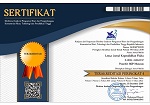IMPLEMENTASI MODEL PEMBELAJARAN 5E UNTUK MENINGKATKAN HASIL BELAJAR DAN KEMAMPUAN BERPIKIR KRITIS SISWA
DOI:
https://doi.org/10.33394/j-lkf.v1i1.71Keywords:
Learning cycle (5E), learning outcomes, critical thinking skills.Abstract
This study aims to improve learning outcomes and critical thinking skills of students SMPN 18 Mataram Academic Year 2012/2013 through the implementation of 5E learning model. The type of research used is classroom action research (PTK). This research is conducted in a cycle consisting of planning, implementation, observation, and reflection. Data on cognitive learning outcomes were obtained from multiple choice tests and critical thinking skills using critical thinking skills tests. The subjects of the research are students of class VIII-A which is 19 people. The results showed that there was an increase in learning outcomes and critical thinking skills due to the 5E learning model. In the first cycle of classical completeness cognitive learning outcomes is 94% and the average value of 82 is categorized completely. Furthermore, critical thinking ability in the first cycle is worth an average of 76 that is completely categorized. It can be concluded that the 5E learning model has been able to improve learning outcomes and students' creative thinking ability.
References
Arikunto,Suharsimi. 2010. Prosedur Penelitian Suatu Pendekatan Praktik (edisi revisi). Jakarta: Rineka Cipta.
Purwanto, R. 2011. Peningkatan Motivasi dan hasil Belajar Siswa pada Kompetensi Sistem Koordinasi Melalui Metode Pembelajaran Teaching Game Team terhadap Siswa Kelas XI IPA SMA Smart Ekselensia Indonesia. Hal 3.
Rai, A. 2001. Quality Improvement Of Learning Process And Basic Competency Student’s Physics In Using “5 E†Models Of Learning. Faculty of Maths and Science Education Ganesha University of Education Singaraja Bali. ISBN : 978-979-98546-4-2, hal 38-43.
Saefudin, A. A. 2012. Pengembangan Kemampuan Berfikir Kritis Siswa dalam Pembelajaran Matematika dengan Pendekatan Pendidikan Matematika Reaslistik Indonesia (PMRI). Al-Bidayah, Vol 4 No. 1, Juni, hal 37-48.
Sudjana, N. 2009. Dasar-Dasar Proses Belajar Mengajar. Bandung : Sinar Baru Algesindo.
Sugiyono. 2011. Metode Penelitian Kuantitatif, Kualitatif, dan R&D. Bandung : Alfabeta.
Sumarsono, J. 2009. Fisika Untuk SMA/MA Kelas X. Jakarta: Pusat Pembukuan.
Wasis. 2006. Contextual Teaching And Learning (CTL) dalam Pembelajaran Sains-Fisika SMP. ISBN : 388-1293-1-PB, Cakrawala Pendidikan, No. 1, Februari, hal 2.
Downloads
Published
How to Cite
Issue
Section
Citation Check
License
Authors who publish with Lensa: Jurnal Kependidikan Fisika agree to the following terms:
- For all articles published in Lensa: Jurnal Kependidikan Fisika, copyright is retained by the authors. Authors give permission to the publisher to announce the work with conditions. When the manuscript is accepted for publication, the authors agree to automatic transfer of the publishing right to the publisher.
- Authors retain copyright and grant the journal right of first publication with the work simultaneously licensed under a Creative Commons Attribution-ShareAlike 4.0 International License that allows others to share the work with an acknowledgment of the work's authorship and initial publication in this journal.
- Authors are able to enter into separate, additional contractual arrangements for the non-exclusive distribution of the journal's published version of the work (e.g., post it to an institutional repository or publish it in a book), with an acknowledgment of its initial publication in this journal.
- Authors are permitted and encouraged to post their work online (e.g., in institutional repositories or on their website) prior to and during the submission process, as it can lead to productive exchanges, as well as earlier and greater citation of published work (See The Effect of Open Access).

This work is licensed under a Creative Commons Attribution-ShareAlike 4.0 International License.

.png)

